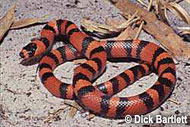Description:
The Honduran milk snake is a very popular tricolored milksnake. It is commonly bred in captivity with several different phases including the "milk snake phase" and the "tangerine phase." Cages should be escape proof, complete with water and hiding area. Kingsnakes and milk snakes must be housed separately (except during the breeding season) because they are cannibalistic. Inexpensive enclosures such as plastic shoe or sweater boxes work well if there are ventilation holes drilled in the sides. Aquariums or home-made enclosures also work well if you want to display the snake. A variety of substrates may be used (aspen shavings, corn-cob-type rodent bedding or newspaper) to keep the animals clean, warm and dry. Kingsnakes will feed on just about anything. They will consume warm-blooded prey such as rodents and birds, as well as cold-blooded prey such as lizards and frogs (in addition to other snakes). Many species adapt well in captivity if kept between 80 and 85 degrees Fahrenheit, with a nighttime temperature drop of five to 10 degrees. Temperature control is important as it maintains feeding response and digestion.
Habitat:
All areas of the range.
Range:
Low to moderate elevations in Nicaragua, northeastern Costa Rica and the Caribbean slope of Honduras.
Scientific Name: Lampropeltis triangulum hondurensis
Species Group: milk-snake
Family: Colubridae
Size: Adults average 48 inches in length.
Level: beginner
Weight:
Dangerous: No


